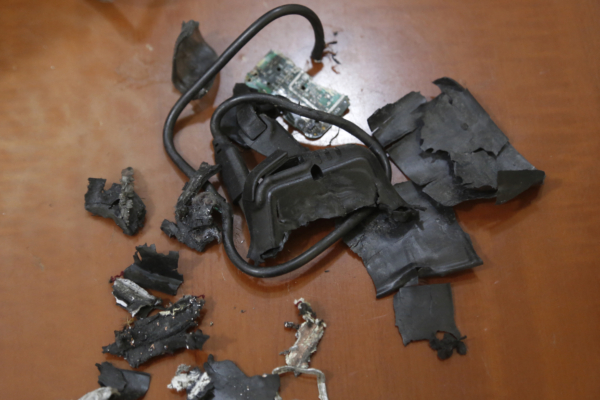Recent signs indicate that Israeli intelligence agency has carried out an unprecedented highly complex spy operation targeting Hezbollah members using communication devices for pinpoint strikes.
Following the historic pager explosion targeting thousands of Hezbollah members on September 17, another wave of similar explosions hit Lebanon on September 18. The second wave of explosions seemed to primarily target the handheld radios used by members of the Iran-backed radical group. While Israel has not claimed responsibility for these attacks, Israeli Defense Minister Gantz announced that the war is entering a “new phase,” focusing on Hezbollah in the northern front.
On the afternoon of the 17th, Hezbollah members received a special message that appeared to be from the leadership triggering explosions of their pagers across Beirut. It is speculated that the pager software was manipulated to trigger the explosions under specific signals. Witnesses reported that the pagers did not explode immediately upon receiving the messages but had a slight delay, providing enough time for the holder to be near it, leading to reports of injuries mainly to the hands and faces of the targeted individuals.
Israeli intelligence has a history of bold and technologically advanced remote assassination operations, although official statements have never linked them to such events. Examples include the remote gunning down of Iranian nuclear expert Mohsen Fakhrizadeh and using explosive-laden mobile phones to assassinate terror operative Yehiyeh Ayash.
Altering pager software and hardware to respond to specific messages in a certain way is one thing, but turning pagers into explosive devices is another. Initial speculations suggested a hacking attack causing the pagers’ batteries to overheat and explode. However, this narrative was quickly replaced with the use of high-energy explosives.
Even a small amount of explosives in close proximity can cause significant lethal damage. It is believed that the explosive devices were inserted into the pagers at some point in the supply chain. If so, it would be a highly intricate process, necessitating a deep understanding of the opponent’s plans, carrying out the modifications clandestinely, and distributing the tampered pagers among the targeted individuals.
Five months ago, around 5,000 pagers were brought into Lebanon as part of Hezbollah’s equipment replacement program. It is speculated that Israeli intelligence intercepted this batch aimed at Hezbollah and embedded explosive materials and control systems in these devices during production to delivery, as investigations revealed these pagers to be the AR-924 model manufactured by Taiwanese company Gold Apollo.
Regardless of the manufacturing details, it is clear that these devices required explosive materials and necessary software modifications to ensure they posed a threat once in Hezbollah’s hands, making this storyline particularly captivating.
This implies that Israeli intelligence was aware of Hezbollah’s pager replacement plan, penetrated the entire supply chain management, and ensured the devices were distributed to every Hezbollah member. Distributing these devices to Hezbollah members and the subsequent explosions this week likely enabled Israeli intelligence to intercept encrypted communications and gather extensive intelligence among Hezbollah members. The chaos caused by the explosions likely compromised Hezbollah’s secure communications and weakened its command structure, leading to disruptions in its operations.
Interestingly, there are indications that Israel hastened the explosion operation due to concerns of being exposed. An anonymous US official disclosed that Israel triggered these devices this week out of fear of Hezbollah’s suspicions, aligning with the Israeli Defense Ministry’s statement about the start of a new phase targeting Hezbollah militarily.
The AR-924 pager, weighing only 95 grams including the battery, would require a very small bomb to make it lethal.
The BLU-43 Dragon’s Tooth, possibly the smallest lethal explosive device manufactured by the US military, with a diameter of about two inches and weighing less than 20 grams, containing only 9 grams of explosives, was used during the Vietnam War. This kind of mine, with just a few grams of explosives, is enough to inflict casualties. The US has recently developed miniature ammunition potentially useful for drone warfare, though details are scarce.
For a pager weighing 95 grams, 9 grams of explosives still seem relatively heavy. Reports cited Hezbollah sources mentioning these explosive devices contained 3 to 5 grams of high explosive material.
There are also claims that the pager battery units were “loaded with explosive PETN.” PETN is a high explosive primarily used for powerful precision demolitions.
Additionally, reports have mentioned that Mossad inserted a circuit board containing explosive material into the equipment, differing from previous claims about explosives being in the battery. Integrating explosives into a circuit board makes it easier to detect but simplifies detonation control. The source mentioned a weight of 3 grams for the explosives.
In summary, all indications point to the pagers being implanted with high explosives and activated via signal control. However, the explosion itself may not be lethal, as shrapnel from the device would be needed. Pagers are often worn on belt clips, facing the wearer’s body, enabling the design of directional explosives, making the lethality much more severe than it appears.
The terrifying nature of electronics exploding on command has caused widespread panic among the Lebanese population. Reports of other electronic devices exploding, including solar panels and fingerprint scanners, have surfaced, yet there is no independent evidence linking them to the Hezbollah pager and radio explosions. Nevertheless, people remain anxious and fearful about what may come next.
Weaponizing electronic devices for warfare raises concerns. With the advancement of mobile communication technologies, this threat has existed since the early 21st century.

